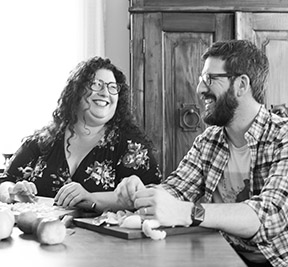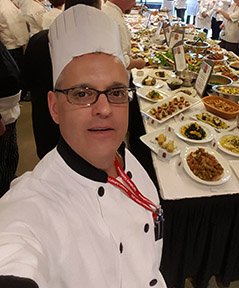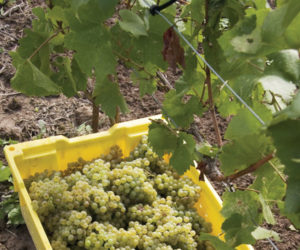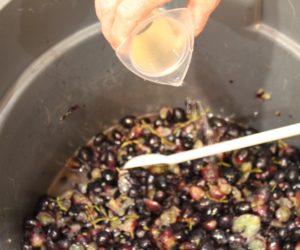One of the best things about wine is how there is a variety out there that pairs perfectly with any dish. However, that pairing doesn’t have to be in a glass served next to your meal — it can also be used as an ingredient in your meal! For help with this we got out our cork screw, opened a bottle, and asked a few chefs to spill their secrets when it comes to cooking with wine.
Matt and Emily Clifton, authors of Nerds with Knives, Cork and Knife , and The Ultimate Dutch Oven Cookbook.

Contrary to popular opinion, there’s really no such thing as “cooking wine.” If a wine is too oxidized/vinegary to drink, you shouldn’t cook with it — it won’t impart any good flavors to your dish.
So what should you use? We find that full-bodied reds without too much sweetness work for long braises and where you want their assertiveness to play off other ingredients in the recipe. Since red wines often have a high tannin content, they work well combined with fatty ingredients where the gelatin will mellow the wine out. Without that fatty balance, a long-cooked red wine can be bitter. We’ll sometimes use a fruity red wine in a dessert recipe where those flavors work well in a sweet setting. Don’t use fine vintages for cooking! Once the wine is cooked into a dish it will lose some of its complexity and you won’t be able to tell it from a cheaper bottle.
For white wines, dry wines add a lot of acidity to brighten a dish, just as a light squeeze of lemon juice right at the end of cooking might do. They can also counteract sweetness in the recipe. White wines have less tannin and are more forgiving of a long cook than red wines. We like light, dry, crisp varieties like Sauvignon Blanc or Pinot Grigio. We don’t use oaked white wines in any large volume, because they tend to overpower the recipe’s other flavors.
A great way to use wine in your cooking is to deglaze a pan — for example, to finish a sautéed dish by adding just enough liquid to dissolve flavorful fond (the tasty brown bits stuck to the bottom of a pan), cook and reduce the wine just enough to create a sauce, develop the wine flavor, and cook out the raw alcohol taste. The variety won’t matter too much for a half a cup or less of dry wine used to deglaze a pan, but when using much more than that, like for a braise, remember that whatever characteristics the wine has as a drink will become much more concentrated.
Sherry, brandy, and Port also all work really well in the kitchen. We use Sherry most of all, and it pairs beautifully when used to finish a dish with onions or mushrooms, or anything with an earthy flavor, for example. Since they’re so assertively flavored, we don’t use them in such large volumes as we would some of the long-cooked wine recipes (like a bourguignon). A half cup or less, cooked down for a few minutes, adds great complexity. Use dry versions for savory dishes and keep the sweet varieties for a boozy dessert.
You can also use wine as a substitute for other ingredients. A splash of white wine can substitute for acidic ingredients like lemon juice. Keep in mind that wines won’t replace other liquids (like stock) with a 1:1 ratio, so you could dilute wine with an equal amount of water to approximate stock.
Another basic tip is to cook a recipe with the same kind of wine you would pair with it to drink. White wine for a shrimp dish, a robust red wine for a beef dish, for example. Also, be careful of introducing wines with funky flavor profiles, as they may cook down in unexpected ways. And of course, look for a copy of Cork and Knife, our book on cooking with booze, which will give you more inspiration!
Stephen Fields, Event Catering Chef at Skidmore College in Saratoga Springs

My approach to cooking with wine is the same approach I use with the addition of any ingredient; I use my sense of taste and smell looking for the desired “texture or mouthfeel” and imagine how the various flavors will come together in the final product.
When asked how does one know what is a good wine for pairing or cooking? My reply is always the same — taste it! If you like the way it tastes, you are in possession of the right wine. Once you have chosen your wine, it is time to start creating. Trust your instincts and senses, following recipes is fine but experimenting is where the real learning starts. This is what keeps the culinary world exciting and new. To help guide your experiments, I have included some specific suggestions by type of wine:
Red wine pairs well with meals containing beef, pork, lamb, wild game, and heavier fish (think swordfish). Try adding the wine to your braising liquid in meals like Ossobuco or to a beef stew. Look for a full-bodied red such as Cabernet Sauvignon, Merlot, and Shiraz. For a lighter option, Pinot Noir is a great choice.
White wine pairs well with most seafood, poultry, and is essential for making rissotto. Try splashing some white wine into a pan to deglaze after sautéing vegetables or pan frying meats. This can then be used as the base of a white wine sauce or glaze. Look for a dry white that is crisp and high in acid with citrus or fruity notes. Low to medium oak will suit you just fine in most dishes. Try some of these selections; Sauvignon Blanc, Chardonnay, Pinot Gris, and if you have an open bottle of Champagne, that works well here too.
Fortified wine pairs well with savory dishes such as veal or pork marsala and desserts like panna cotta and zabaglione. When it comes to adding wine to desserts, it is important to master the dessert recipe and then experiment with the addition of wine. Fortunately for us, panna cotta goes just as well with a glass of Port wine as it does with a bit of brandy added in. An easy recipe to try your hand at cooking with wine is French onion soup. This can be made with a Sherry or Chardonnay (look for a lighter or unoaked Chardonnay). For a dessert pairing, look for a Madeira or Port, and for savory dishes try Sherry or marsala.
Here are a few more tips that apply to cooking with any kind of wine:
1. Freeze leftover wine into ice cube trays for future dishes. When adding wine to a dish, you are attempting to enhance the dish with the flavors left after the alcohol is cooked off. This makes it crucial to use a good tasting wine that has not turned, which is why freezing that leftover wine instead of letting it oxidize in an open bottle in the fridge helps.
2. Add your wine into the dish early enough to cook off the alcohol. Although we enjoy the full flavor of wine in the glass, if the alcohol has not cooked off it may leave your dish with a bitter flavor.
3. Less is more – you will rarely use more than 4 oz. (120 mL) of wine in any recipe.
4. If you have a recipe that calls for wine and you’re all out, fear not. Wine can be substituted by red wine vinegar, white vinegar, apple cider vinegar, fruit juices (lemon, cranberry, and apple), and stock (seafood, beef, and chicken). Stock can be substituted 1:1 but vinegar and juice should be diluted with water or stock.
To my fellow winemakers, instead of discarding or composting the gross lees at the end of primary fermentation, try dehydrating the sediment for smoking chips. This can be done by spreading the sediment on a sheet pan covered with wax paper and dehydrating in the oven at 200 °F (93 °C) for six hours. Then break the sheet up into chips to use with your favorite smoking recipe. I like to use a combination of regular chips with the wine sediment. When used as an addition to smoking, these chips produce a very earthy flavor. The food will take on faint notes of almond, bread, and also the flavor of the particular wine that was produced.
Remember these are very basic guidelines. In the end, your dishes are of your own creation. Allow yourself room for experimentation and if you fail, try again.






